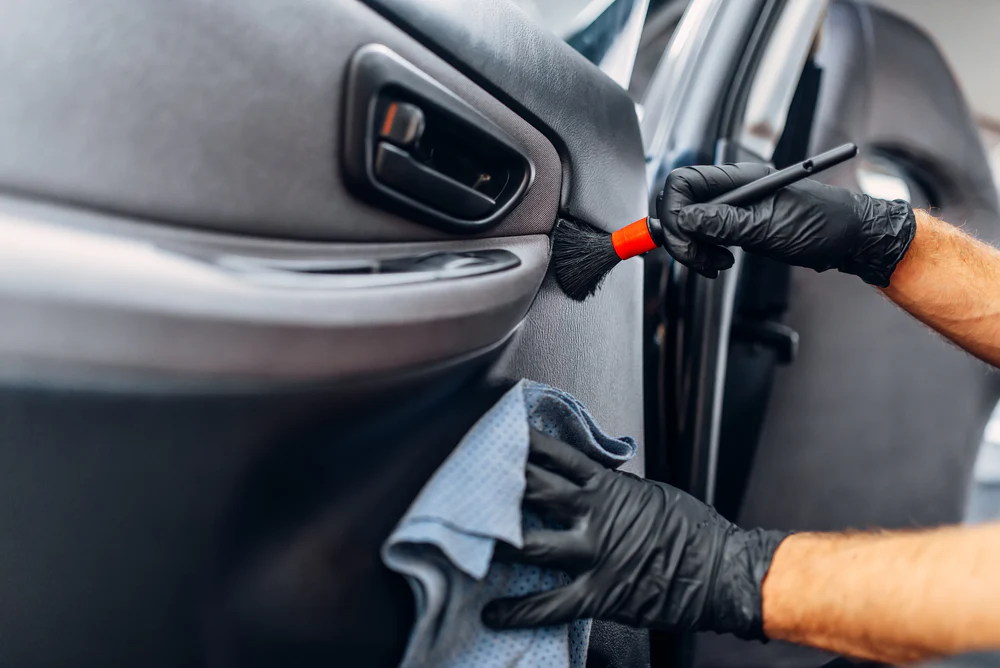
How To Clean Interior Plastic
How to clean interior plastics
The design of vehicle interiors can vary depending on the brand, price point and the purpose it’s designed for. Whatever the sector, most vehicles will have an assortment of plastics forming part of the dashboard and trim features. It may be a textured surface or piano-black plastic, or a ‘carbon fibre’ effect: Higher end models may even have real carbon fibre. Whatever the plastic type, they will all still get dirty and need to be cleaned. Here is how to do it:
What you will need
- Vacuum cleaner with various head attachments
- Bucket of warm, clean water
- Detailing brush (ideally soft bristled)
- Selection of microfibre cloths
- Drying towel All Purpose Cleaner (APC)
- Interior Detailer
How to clean interior plastics
We are in and out of our cars all the time, dragging in dust and dirt while adding finger marks and stains to the interior surfaces. Cleaning your car interior isn’t difficult and can be part of your regular maintenance routine and it can make all the difference to the driving experience.
Start by emptying the vehicle of any personal belongings, rubbish or debris before vacuuming throughout to remove any loose surface dust and dirt. You may wish to use various tool attachments to help get into the nooks and crannies.
Moving on to the plastics and there may be some areas more heavily soiled than others such as door sills and around the footwell where footwear may have scuffed against the surface. Address these areas first by wiping them down with a clean, damp microfibre cloth to remove the built-up dirt.
If you choose to wash any of the surfaces, then you will need to be cautious as car electronics do not take kindly to water so steer clear of any areas that contain technology and have a good quality drying towel at hand to dry the surfaces.
To clean the rest of the interior, use an All Purpose Cleaner that is designed for multiple surfaces to remove any stubborn marks and spillage stains, leaving a clean, shiny surface.
Top Tip: To avoid overspray, do not spray the product directly onto the surface but instead spray it sparingly and directly onto a clean microfibre cloth. Microfibre cloths are designed to collect dirt within the fibres rather than just spreading it about and of course they can be washed and reused. It’s worth the extra effort.
Get the showroom finish
As described above, a good vacuuming followed by an All Purpose Cleaner will make light work of most interior surfaces but for that extra special touch, try using an Interior Detailer spray that is suitable for use on plastic, vinyl and metal surfaces. The Interior Detailer will leave a fresh, clean original equipment manufacturer (OEM) finish, with the additional bonus of being anti-static, repelling dust. It's a worthwhile additional step to clean your car interior.
How to clean black interior plastics
Some trim, perhaps textured or anonymous grey plastic, doesn’t show up the dust to the same extent. Black plastic trim however, like the popular shiny piano-black finish, is the worst culprit for showing up dust and marks, similarly with touchscreen surfaces. Clean these gently using an anti-static Interior Detailer on a clean, dry microfibre cloth. Use it sparingly and it will help prevent dust build-up.
How to clean interior plastic trim
Ensure the doors have been emptied of any rubbish and give a good vacuum. Using the vacuum tool attachments, especially the brush heads to avoid scratching the plastic surfaces and to get into the nooks and crannies. It might help to use detail brushes for around the air vents, switchgear etc.
How to clean hard interior plastics
Hard plastics are prone to scratching so it is best to go gentle when using any tools. A wipe down with a damp microfibre cloth will be a good start and use All Purpose Cleaner to remove any stubborn marks. Remember, water and electrics don’t mix so best to avoid using copious amounts of water and make sure you spray products onto the cloth rather than over the interior surfaces.
How to clean mud off car interior plastic
Being out and about attracts mud and dirt that then gets trodden into the car, especially in winter. Boots tend to be scuffed and rubbed against door trims for example. Trying to wipe away wet mud will only result in spreading it further. It is better to allow it to dry and then brush away using a soft bristle brush. Do not use a hard brush as it could score and mark the surfaces. If the mud is persistent then you may wish to wash the area using a damp microfibre cloth. Alternatively, All Purpose Cleaner will be able to remove any residue and stains. Finishing with a touch of Interior Detailer to return the plastic to that ‘as new’ showroom finish.
How to clean textured interior plastics
Some car interiors feature textured or grooved surfaces. The plastic trim around the door shuts is a case in point. Following the same cleaning process as before but this time deploy a soft detail brush to get into the grooves of the textured surface that may have otherwise been missed.
Good car maintenance and cleaning, inside and out, is very satisfying. Step back and admire your handiwork. A fresh clean interior makes motoring a pleasant experience. A car that is well maintained will hold its value better too.

